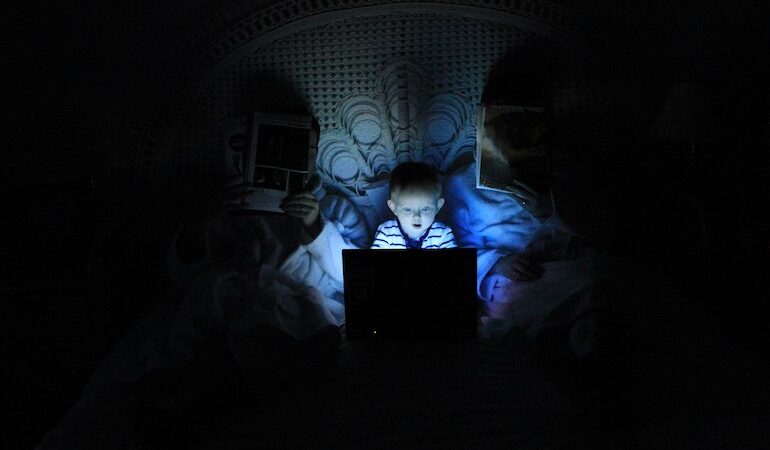During my years in various English Departments, I loved teaching Macbeth. There’s so much in it—art and psychology, mayhem and mystery, beauty and terror. Plus, there were moments when I got to act as an ambassador from a distant past. It was an honor to be the one to introduce members of a new generation to Banquo’s ghost.
And yet.
And yet, I can’t help but wonder if the most consequential learning experience a student had in those classes was not her moment with Lady Macbeth wandering the castle mad with grief and guilt but the time she spent peeking at her phone while she was doing her homework.
As a parent, you don’t need data to tell you that our kids are growing up in a media-saturated world. But the numbers help paint the picture:
-
-
- By age 12, 69% of kids own a smartphone, giving them round-the-clock access to media (Common Sense Media, 2019).
-
- Teens now spend over 7 hours per day on screens for entertainment alone—not including schoolwork (Common Sense Media, 2019).
-
- U.S. teens spend an average of 4.8 hours a day using the seven most popular social media apps (American Psychological Association, 2024).
- Meanwhile, American adults spend over 11 hours per day consuming media, according to Nielsen’s 2019 report.
-
The controls that once mediated media exposure—TV schedules, limited access to devices—have largely vanished. Many of today’s kids are not only consumers of media but also participants in a 24/7 digital world that shapes their understanding of themselves and others.
The good news for families at Marin Montessori School is that our approach to technology provides a powerful counterbalance to this reality. As highlighted in Real Fear, Real Hope, we have intentionally designed our programs to allow children to engage deeply in the real, tangible world around them.
This distinctive and deliberate approach positions MMS as a bit of an outlier, giving our students the rare gift of time to think, question, and create without constant digital interference.
Eventually, though, we all leave the refuge and step into the digital media-saturated world.
Media, the Teacher
Teachers matter, not only because they provide guidance, knowledge, and feedback but because they model ways of being in the world. They show as much as they tell.
The media teaches and teaches and teaches—through TikTok dances, YouTube algorithms, Netflix dramas, Instagram influencers, and video game narratives. It conveys truths and lies about what to believe, how to behave, where to find value, and where not to find it.
The term media is actually a misnomer. As the plural form of the word medium, the media is the intermediary between the individual and the world. The media is not the content; it’s the lens.
Ever since the invention of the printing press, human beings have increasingly understood the world not through lived experience but via the mediums that re-present reality.
This act of re-presenting, as in presenting again, has itself become a misnomer because it suggests that the audience has had an experience on its own and that the medium is simply presenting that experience for a second or subsequent time.
The reality, of course, is that the vast, vast majority of what we understand as reality is delivered to us exclusively through an intermediary – which is why understanding the prerogatives, incentives, and structures of the mediums is so essential – and empowering.
In the Media Literacy courses I taught for over 20 years, I saw students become activated as they shifted from passive consumers of media to active critics. They found language to articulate their disillusionment with the media narratives that push and pull them. They learned to question, to challenge, and to choose.
This is the heart of Media Literacy: the acquisition and refinement of skills, language, and habits of interpretation of the texts that our culture presents as trivial.
At Marin Montessori, we believe in fostering lifelong learners. Media Literacy is no exception. Through observation, critical thinking, and independence, Montessori education lays the groundwork for children to navigate their digital lives with confidence and clarity.
What Montessori Already Offers
At Marin Montessori School, we imbue students with many of the foundational skills they need to navigate their media-saturated world.
-
-
- Observation: In Montessori, children are taught to observe closely—whether it’s watching how a peer builds a tower or identifying patterns in nature. This habit of mindful observation translates directly to evaluating media critically: What am I seeing? What’s the purpose? What’s missing?
-
- Critical Thinking: Montessori classrooms foster curiosity and problem-solving. Whether it’s analyzing the mechanics of a simple machine or debating a historical event, these experiences build the capacity to question narratives and seek evidence.
- Independence: From an early age, Montessori students learn to make choices and take responsibility for their learning. This independence equips them to navigate digital spaces with more awareness and less susceptibility to manipulation.
-
Parents as Media Mentors
Even with these foundational skills, parents play a crucial role in helping children make sense of media. Here are some strategies to consider:
-
-
- Ask Questions: Instead of telling your child what to think, ask them what they notice. If they’re watching a YouTube video, ask: “Why do you think this person made this? What are they trying to say?”
-
- Model Media Habits: Children learn from what they see. If you’re constantly scrolling or reacting emotionally to news, they’ll pick up on that. Instead, model balance—set limits, take breaks, and engage with media intentionally.
-
- Decode Together: Watch a favorite show or ad with your child and talk about it. What’s the message? Who’s the audience? What techniques are being used to capture attention?
- Name the Villain: When you’re the one monitoring screen time, it’s easy to become the villain in the story your kids are telling. Instead, as appropriate, engage them in an exploration of the incentives and the consequences behind the media they encounter. They’ll discover the billions of dollars that have been invested to engage, addict, discourage, and bait them. I found that opening the metaphoric hood and examining the gears and the fuel that make the machine run can help kids focus their dismay on the proper sources.
-
Moving Forward
As parents, it’s easy to feel overwhelmed by the ubiquity of media and its potential pitfalls. But by embracing Montessori principles at home and fostering open, honest conversations about media, we can guide our children toward a healthier relationship with the digital world.

Terry is the Director of Communications and Story at Marin Montessori School. A classroom teacher for 30 years, he manages Grounded and Soaring.





